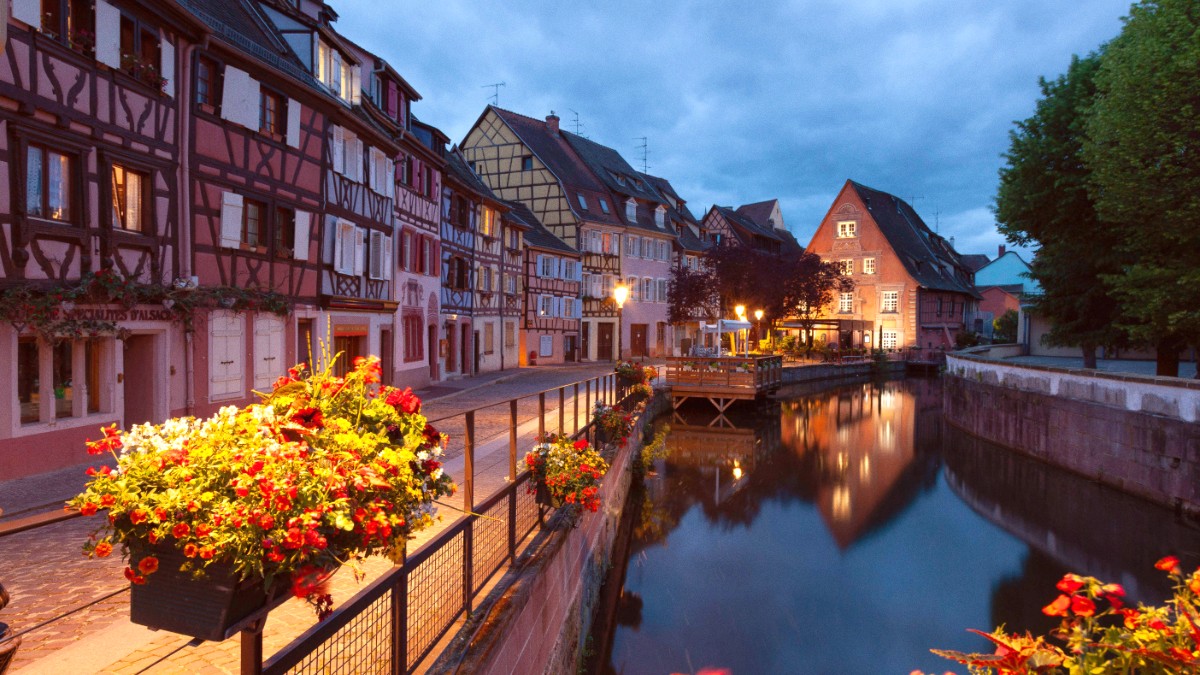
France
Alsatian food is often described as "French cuisine with a German accent." It is hearty, focusing on pork, potatoes, and cabbage, reflecting its peasant origins and the need for warming, substantial meals in a cooler climate.
French culinary techniques appear, notably in sauces and the use of wine. The region's rich wine culture also is a significant place, with local white wines frequently finding use in cooking and as pairings.
Lunch (déjeuner) typically runs from 12:00 PM to 2:00 PM. Dinner (dîner) generally starts later, from 7:00 PM and can extend to 9:30 PM or later. Many restaurants close between lunch and dinner service.
Always greet restaurant staff with a polite "Bonjour" or "Bonsoir." A simple "Merci" when leaving is appreciated. A service charge ("service compris") is typically part of the bill under French law. Tipping is discretionary.
Bread often accompanies meals and is typically placed directly on the table. It is for wiping up sauces. Tap water ("une carafe d'eau") is free and available upon request. Bottled water incurs an extra charge.
The quintessential Alsatian dish. Fermented cabbage (sauerkraut) braised with white wine (often Riesling), with various cuts of smoked and boiled pork. Served with boiled potatoes.
Find it at: Traditional Alsatian restaurants, known as "Winstubs."
A very thin, crispy crust, similar to pizza. Topped with crème fraîche, thinly sliced onions, and lardons. Baked quickly in a wood-fired oven.
Find it at: "Flammeries" or most traditional Alsatian restaurants. A great light meal.
A rich casserole dish with layers of sliced potatoes, onions, and various marinated meats slow-cooked in a sealed ceramic dish with white wine and herbs.
Find it at: Traditional Winstubs. Not always available daily due to long preparation.
A traditional spiced bread, especially popular during the Christmas season.
Kugelhopf is a brioche-like cake baked in a fluted mold. Tarte aux Myrtilles is a delicious blueberry tart, popular in summer.
Colmar offers several highly-regarded restaurants for a refined culinary experience.
This category offers a wide selection, many of which are traditional "Winstubs."
Inexpensive options for a quick bite or local experience.
Located in Little Venice, this indoor market is open most days (closed Mondays). It is a fantastic place for gathering picnic ingredients or soaking in the local atmosphere.
Find fresh local produce, cheeses, charcuterie, and baked items.
Regular outdoor markets take place at various squares in Colmar, like Place des Dominicains and Place de l'Ancienne Douane. These offer fresh produce, regional delicacies, and sometimes crafts.
Check the Colmar Tourist Office for specific market days.
While Alsatian and French cuisine dominates, Colmar has a limited selection of international restaurants (Italian, Asian), mostly in the city center.
Increasingly available in modern restaurants. Tarte Flambée can often be ordered "sans lardons" (without bacon).
More challenging in traditional restaurants. Specify "sans viande, sans poisson, sans produits laitiers, sans oeufs."
Awareness of gluten-free is growing. Carry a card in French explaining needs (e.g., "Je suis allergique à le gluten").
Awareness of gluten-free ("sans gluten") and other allergens is growing in France, though not as widespread as in some countries.
Carry a small card written in French explaining dietary needs (e.g., "Je suis allergique à le gluten" - I am allergic to gluten).
Supermarkets often stock gluten-free products ("produits sans gluten").
When in doubt, simple dishes like salads (ensure no hidden meat/cheese), roasted potatoes, or fresh fruit are usually safe choices. Preparing your own meals from market purchases is often the simplest solution for strict dietary needs.
Use online search engines for "restaurant végétarien Colmar," "restaurant vegan Colmar," or "restaurant sans gluten Colmar."
Direct communication with restaurant staff is . Use simple, clear French phrases or a translation app.
Learn to prepare authentic Alsatian specialties like Tarte Flambée, Baeckeoffe, or traditional gingerbread (Pain d'Épices). Inquire at the tourist office or search online.
Many vineyards along the Alsace Wine Route conduct guided wine tasting workshops. This path to learning about the region's famous white wines comes directly from the producers.
Some local farms (Ferme auberge) in the countryside serve meals with their own produce, an authentic rural dining experience.
Purchase fresh bread, cheese, charcuterie, and wine from the Covered Market or a local bakery. Enjoy a scenic picnic along the Lauch River in Little Venice.
A simple, enjoyable way to experience local flavors.
Look for Bretzels (soft pretzels) at bakeries and street stalls. Mannele (brioche figures) appear around St. Nicholas Day. Choucroute Hot Dogs offer a local take on fast food.
Quick and authentic bites on the go.
The region is famous for its typically single-varietal white wines, named after the grape: Riesling (dry, aromatic), Gewürztraminer (full-bodied, spicy), Pinot Gris (rich, smoky), Muscat (dry, intensely grapey), Sylvaner (light, refreshing), and Pinot Blanc (soft, fruity).
Crémant d'Alsace is a sparkling wine made using the traditional method, a fine choice as an aperitif or for celebrations.
Local beers are popular, often light lagers or pilsners. Eau de Vie, fruit brandies like Kirsch (cherry) and Mirabelle (plum), are strong spirits often served as a digestif.
Bookings for dinner are recommended, especially on weekends, at popular establishments, or for larger groups.